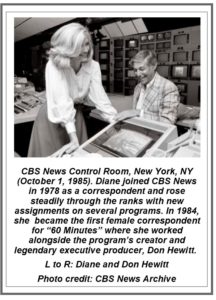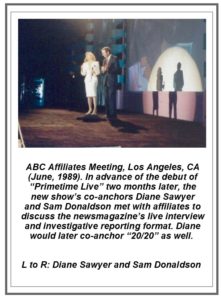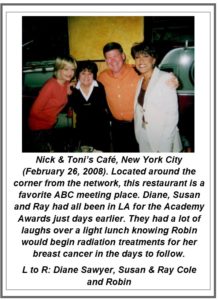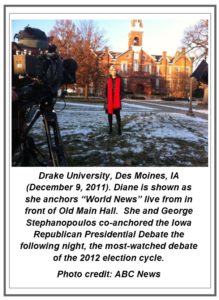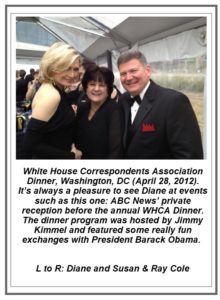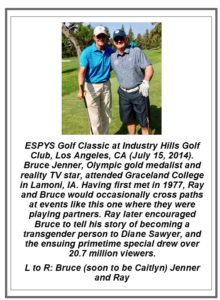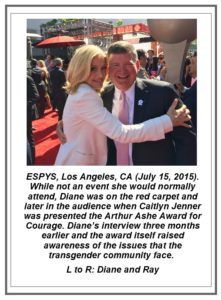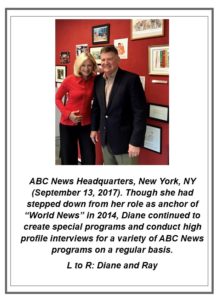“Diane Sawyer always thinks very deeply and creatively and tries to understand not just the story, but the underlying currents of the story; the parts that you wouldn’t know about or have thought about. She sees the indirection, the subtlety, the nuance of a story better than anyone.”
~David Westin, former president of ABC News, in “Hangin’ with Winners”
Lila Diane Sawyer established herself as one of the most recognized — and widely respected — faces in television news. She once said, “Follow what you are genuinely passionate about and let that guide you.” That sage advice served her well, although nothing about her progression as a trailblazing female journalist was easy or ordinary.
A native of Kentucky, Diane won first place in the 1963 national America Junior Miss scholarship pageant. She returned to her home state after graduation from Wellesley College to work as the “weather girl” for WLKY-TV in Louisville. Diane showed a keen interest in news, and demonstrated the kind of initiative that led to occasional news assignments. A story she produced on Supreme Court Justice William O. Douglas prompted a hard-earned promotion to a full-time general assignment reporter position.
Diane’s journalism career was put on hold in 1970 when “following what she was passionate about” meant moving to Washington, D.C. to work in the Nixon White House as a press assistant. Only 25 years old at the time, Diane would later reflect on the pressure associated with such job saying, “I remember the terror, the terror of making a mistake. A mistake I made could alter history.” She would personally witness Nixon’s fall from grace which led to his resignation from the presidency in August 1974. Diane served on the Nixon-Ford transition team, and then helped Nixon write his memoir.
In a final plot twist to her government service, a close Nixon confidant later insisted that Diane was the infamous Deep Throat informant during Watergate. She laughed it off at first, but eventually requested that Washington Post reporter Bob Woodward issue a public denial. Deep Throat’s identity was eventually revealed to be former F.B.I. deputy director Mark Felt in a Vanity Fair story in 2005.
Diane put herself back on a solid journalistic career path in 1978 with a return to reporting as a correspondent for CBS News. She would spend ten plus years there, rising steadily through the ranks with a series of assignments on several programs including co-anchor of CBS Morning News with legendary television journalist Charles Kuralt from 1982 to 1984. But no promotion was bigger than the one in 1984 when Diane became the first female correspondent for CBS’s marquee news magazine, 60 Minutes.
Shortly after leaving CBS News in 1989, Diane and Sam Donaldson were officially introduced to ABC affiliates as the co-anchors of a new magazine show, Primetime Live, at an affiliate meeting in Los Angeles. Spending time with Diane at affiliate and board of governors meetings would become a regular occurrence over the next 30 years. We would also see each other at events ranging from political debates to the Academy Awards, from a White House Correspondents Association dinner to the ESPYS. It was also enjoyable to get together for an occasional breakfast or lunch meeting, more often to discuss the latest happenings in our personal lives as opposed to current events or network business.
It didn’t take long for Diane to establish a presence at ABC News as she conducted some of the biggest, most exclusive interviews with newsmakers from all around the world. In 1990, she spoke to Iraqi President Saddam Hussein in his first interview with a western journalist in almost a decade. In 1992, Diane landed the first interview with President-elect Bill Clinton and his wife, Hillary Clinton in their Arkansas home. In one of the most talked about interviews of 1995, Diane spoke exclusively with Michael Jackson and his then-wife Lisa Marie Presley. It was Jackson’s first interview since facing child molestation accusations in 1993. It would be the only joint interview ever given by both Jackson and Presley, and it was seen by nearly 60 million viewers.
After holding co-anchor roles for both Primetime Live and 20/20, Diane returned to morning news in 1999 as co-anchor of Good Morning America. While this assignment was supposed to be temporary, she would remain in this role as GMA closed the gap on NBC’s front-running Today show. In 2003, Diane sat down with former President George W. Bush in his first one-on-one interview following the capture of Iraqi President Saddam Hussein. In 2006, Diane was granted rare access to North Korea where she told GMA viewers that her visa was “one of the rarest things you could ever see in journalism.” During that same year, she became the only American journalist to report live from not only North Korea, but Syria, Afghanistan, Iran and Saudi Arabia as well.
One of Diane’s most emotional interviews took place in 2007 when she sat down with former First Lady Nancy Reagan to discuss her husband’s struggle with Alzheimer’s disease. But her most memorable work on Good Morning America tragically played out on September 11, 2001 when Diane and Charles Gibson began ABC News’ award-winning coverage of the attacks on the World Trade Center and the Pentagon. In the days that followed, she reported live from Ground Zero, and would later interview more than 60 widows who gave birth after the World Trade Center disaster.
It was also during her time at Good Morning America that I was able to observe how incredibly caring and supportive Diane was during the time her friend and co-anchor, Robin Roberts, battled breast cancer. My wife, Susan, and I had lunch in New York City with Diane and Robin in February 2008. Robin had just finished the last of her chemotherapy treatments, and was about to begin radiation treatments. Even though she had taken a red-eye flight back to New York after anchoring GMA’s coverage of the Academy Awards the day before, Diane insisted on joining us for lunch at this important time in Robin’s cancer treatments. Diane’s support would become even more crucial a few years later in 2012 when Robin was diagnosed with MDS, or myelodysplastic syndrome, a rare blood disorder likely caused by the cancer treatments Robin had received years earlier.
In December 2009, Diane left Good Morning America in order to succeed Charles Gibson as anchor of World News. She would lead the flagship news broadcast to new heights, while also serving as the network’s principal anchor for breaking-news coverage, election coverage and special events. By the time she stepped down in June 2014, Diane had covered all the big stories and conducted interviews with nearly every major news maker:
2009 – Kicked off her new World News role by confronting Iranian President Mahmoud Ahmadinejad about his country’s nuclear ambitions.
2010 – Travelled with U.S. General Stanley McChrystal through the battlefields in Afghanistan as he advanced his view that if more troops were not deployed, the mission would fail; sat down with Afghan President Hamid Karzai about his highly contested reelection; reported from Haiti on the aftermath of the devastating earthquake, including visits to orphanages where she observed the “staggering” number of parentless children; anchored a primetime special to address misconceptions about Muslims following the controversy over the building of an Islamic community center near Ground Zero in New York; took World News Tonight on a rare trip to China to report on the country’s progress in the areas of education, transportation and green technologies.
2011 – Japan was hit with a devastating trifecta of disasters in the form of an earthquake, tsunami and nuclear emergency, and Diane was the only evening news anchor to report live from Japan on the aftermath; talked exclusively with Commander Mark Kelly in the wake of the tragic shooting of his wife, Rep. Gabrielle Giffords; conducted the first joint interview of outgoing Secretary of Defense Robert Gates and General David Petraeus in Afghanistan; conducted the first interview with Secretary of State Hillary Clinton after the U.S. took military action in Libya; talked exclusively with the victim of a high-profile child kidnapping, Jaycee Dugard.
2012 – Throughout 2012, Diane anchored ABC News “Your Voice, Your Vote” coverage of the Presidential election along with George Stephanopoulos; she conducted the first interview with Mitt and Ann Romney after he secured the Republican nomination for president, and the first interview with Barack Obama after the pivotal first presidential debate.
2013 – Anchored live coverage from Washington, DC of the Presidential Inauguration; from Boston during the aftermath of the bombing at the Boston Marathon; and from the Vatican during the historic transition to a new Pope. Diane interviewed Malala Yousafzai, the young girl shot in the head by Taliban assassins simply because she wanted to go to school; talked exclusively with Amanda Knox, the college student who was exonerated of murder charges after spending four years in Italy; and sat down with President George W. Bush and former First Lady Laura Bush on the eve of the opening of the George W. Bush Presidential Center.
2014 – Sat down with former Secretary of State, Senator and First Lady Hillary Clinton for the first televised interview about her new book; met with New Jersey Governor Chris Christie for the first interview following his George Washington Bridge-gate press conference; and provided the kind of inspirational leadership that led to ABC News winning the Edward R. Murrow Award for Overall Excellence in Television.
Diane could demonstrate grit, determination and toughness when it was required. In December 2011, we collaborated with ABC News on the production of the Iowa Republican Presidential Debate. Diane and George Stephanopoulos co-anchored the debate that was broadcast live from Old Main Hall on the campus of Drake University. Diane was feeling just plain lousy with a bad cold and touch of flu in the days before and day of the debate, but she gutted it out like the pro she is. It turned out to be worth the effort as the broadcast was the most-watched debate of the 2012 political cycle, and kick-started ABC News’ “Your Voice, Your Vote” coverage in the months that followed.
Most network evening news anchors have traditionally employed a standard sign off at the end of their broadcast. Diane would conclude each World News with “I’ll see you right back here tomorrow night.” That changed on August 27, 2014 when she anchored the network’s flagship news program for the final time, and said goodbye in a more personal way: “And now it is time to say good night. And I just want you to know what a deep privilege it has been to sit in the anchor chair at World News Tonight these years, the flagship broadcast of ABC, where Peter Jennings created a signature of such curiosity and courage. It has been wonderful to be the home port for the brave and brilliant forces of ABC News around the world and to feel every single night you and I were in a conversation about the day together … And with gratitude for these years, I thank you and I’ll see you right back here on ABC News very soon. Good night.”
Diane’s extensive body of work also includes original reporting, long-form interviews and in-depth investigations. Even while serving as an anchor for Good Morning America or World News Tonight, Diane regularly produced a series of reports called Hidden America. These special reports have given voice to the voiceless and illuminated truths long obscured by the partisan squabbles that play out as theater in Washington, D.C. “It’s not always about the interviews with the famous and infamous,” Diane told me in a deeply reflective way. “I’m always amazed at the eloquence, the resilience, the enormous intelligence and brilliance of people who are not in the magazines. And that you can wander up that hill and any mountain in eastern Kentucky and find a universe of ideas and hope and talent, and the continued belief in the possibility of life. Every single time it strikes me with a new thunderbolt that this is who we are. And if everyone is given a chance to thrive and dream, a way to do it and a way to get there, then the world is changed.”
One of Diane’s biggest interviews was presented in April 2015. It was also one with which I had the slightest of connections. Bruce Jenner was a former Olympic gold-winning decathlete and reality television star. The New York native attended Graceland College (now Graceland University) in Lamoni, Iowa. Bruce was my playing partner in the ESPYS Golf Classic in July 2014 at a time when the tabloids were reporting that he had begun the transition to a woman. None of the rumors mattered during our round that day, and we had a great time as he entertained our foursome with stories about the recent, elaborate wedding of stepdaughter Kim Kardashian and Kanye West.
Later that year, media reports confirmed that Bruce would, in fact, be coming out as a transgender woman and was looking for the “right” person to whom his story could be told. I sent Bruce a note encouraging him to consider sitting down with Diane Sawyer who would, in my view, avoid the sensationalism that could easily swamp such a sensitive topic. In the ensuing interview, Bruce confirmed all the speculation saying, “Yes, for all intents and purposes, I’m a woman.” The two-hour, wide-ranging special was a ratings hit that rivaled some of Diane’s other high profile interviews. But more importantly, it was recognized as a critical success for raising the bar on the reporting of transgender issues. Writing for The Huffington Post (now HuffPost), Gabriel Arana said the following: “What Diane Sawyer and ABC did was give Jenner something transgender people are so often robbed of: the opportunity to define and speak for themselves. Sawyer treated Jenner with respect, kindness and empathy, going to great lengths to let Jenner tell his own story.”
Diane Sawyer is a WINNER whose anchoring, original reporting, in-depth investigations and long-form interviews have defined a remarkable career. There are few experiences throughout one’s broadcasting career that can match the sense of pride that rises up when calling her a colleague, or the feeling of joy that comes from being the beneficiary of her friendship.
Sources
Websites –
“Diane Sawyer’s Biography” Retrieved from www.abcnews.go.com
(February 10, 2009). “’A Hidden America: Children of the Mountains’” (Retrieved from www.abcnews.go.com
(May 30, 2010). “ABC News Anchor Diane Sawyer Is 2010 Cronkite Award Recipient” Retrieved from www.cronkite.asu.edu
(October 14, 2011). “20/20: A Hidden America – Children of the Plains” Retrieved from www.amazon.com
(October 18, 2012). “Hidden America: ‘Don’t Shoot, I Want to Grow Up’ I Diane Sawyer investigates the impact of gang violence in America” Retrieved from www.abc7chicago.com
(June 25, 2014). “Diane Sawyer to Step Down as ‘World News’ Anchor” Retrieved from www.abcnews.go.com
Yahr, Emily (August 27, 2014). “Diane Sawyer says goodbye to ‘ABC World News’ with little fanfare; read her farewell speech” Retrieved from www.washingtonpost.com
Taibi, Catherine (August 28, 2014). “Diane Sawyer’s Most ‘Special’ ABC News Career Moments” Retrieved from www.huffingtonpost.com
Pallotta, Frank (April 24, 2015). “Jenner, Lewinsky, LeBron: 8 TV interviews everyone watched” Retrieved from www.money.cnn.com
Stelter, Brian and Pallotta, Frank (April 25, 2015). “Bruce Jenner interview: ‘Yes, for all intents and purposes, I’m a woman’” Retrieved from www.money.cnn.com
Arana, Gabriel (April 25, 2015). “Bruce Jenner’s Special With Diane Sawyer on ABC’s 20/20 Sets New Bar For Reporting On Transgender Issues” Retrieved from www.huffingtonpost.com
Patten, Dominic (April 29, 2015). “Bruce Jenner Interview Ratings Hits Newsmag Demo Record In Live+3” Retrieved from www.deadline.com
Nesheim, Jay Jay (June 1, 2015). “Caitlyn Jenner to be Honored with the Arthur Ashe Courage Award at The 2015 ESPYS on ABC July 15” Retrieved from www.espnmediazone.com
Last Updated: October 30, 2022

